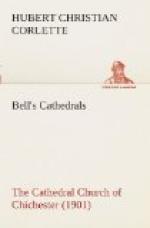Some flying-buttresses were built now in order to meet the thrust exerted by the new arched vault of the nave. These were constructed in two series, one being concealed under the sloping roof over the triforium and acting in place of the earlier round-arched abutment. Its supports were provided at the points where the transverse and diagonal arches of the nave vault began to spring away from the vertical plane of the walls. The other series was the immediate counter-poise to any direct thrust exerted by the arching of the vault against the upper section of the same walls. There was, in fact, a large buttress added to support these nave walls at that point from which each set of vault-carrying ribs began to rise. This buttress, though apparently sub-divided, was one thing, but of composite structure. It was pierced first by the aisle, next by the triforium, and then again above the roof of the triforium. It will be seen that most of these alterations were the direct result of the introduction of a stone vault. But the almost entire renewal of the eastern part of the cathedral was made possible by the destruction and total removal of the apsidal terminations of the earlier work. It has been suggested that the fire may have so badly damaged this portion as to allow no alternative but rebuilding. What may have been the actual cause of its removal it is impossible for us now to know; but the substitute is quite a perfect piece of work of its kind. This ambulatory, or presbytery, as it is commonly misnamed, was nearly all newly built from the foundations during the first half of the thirteenth century. The continuation of the arcade, the triforium, the clerestory, and the vault, the vaulting of the aisles and the chapels forming their terminations eastwards,—all this, with the new arch at the entrance to the earlier lady-chapel, was work of the same date.




